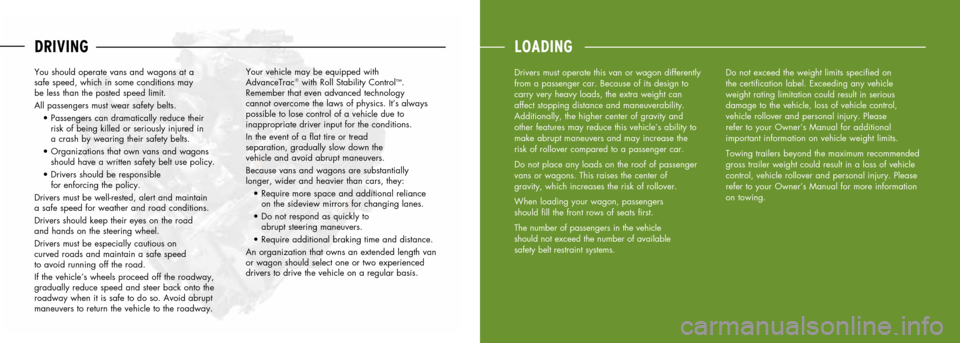run flat FORD E SERIES 2015 4.G Quick Reference Safety Guide
[x] Cancel search | Manufacturer: FORD, Model Year: 2015, Model line: E SERIES, Model: FORD E SERIES 2015 4.GPages: 2, PDF Size: 0.59 MB
Page 2 of 2

You should operate vans and wagons at a
safe speed, which in some conditions may
be less than the posted speed limit.
All passengers must wear safety belts.
• Passengers can dramatically reduce their
risk of being killed or seriously injured in
a crash by wearing their safety belts.
• Organizations that own vans and wagons
should have a written safety belt use policy.
• Drivers should be responsible
for enforcing the policy.
Drivers must be well-rested, alert and maintain
a safe speed for weather and road conditions.
Drivers should keep their eyes on the road
and hands on the steering wheel.
Drivers must be especially cautious on
curved roads and maintain a safe speed
to avoid running off the road.
If the vehicle’s wheels proceed off the roadway,
gradually reduce speed and steer back onto the
roadway when it is safe to do so. Avoid abrupt
maneuvers to return the vehicle to the roadway. Your vehicle may be equipped with
AdvanceTrac® with Roll Stability Control™.
Remember that even advanced technology
cannot overcome the laws of physics. It’s always
possible to lose control of a vehicle due to
inappropriate driver input for the conditions.
In the event of a flat tire or tread
separation, gradually slow down the
vehicle and avoid abrupt maneuvers.
Because vans and wagons are substantially
longer, wider and heavier than cars, they:
• Require more space and additional reliance
on the sideview mirrors for changing lanes.
• Do not respond as quickly to
abrupt steering maneuvers.
• Require additional braking time and distance.
An organization that owns an extended length van
or wagon should select one or two experienced
drivers to drive the vehicle on a regular basis.
DRIVING
Drivers must operate this van or wagon differently
from a passenger car. Because of its design to
carry very heavy loads, the extra weight can
affect stopping distance and maneuverability.
Additionally, the higher center of gravity and
other features may reduce this vehicle’s ability to
make abrupt maneuvers and may increase the
risk of rollover compared to a passenger car.
Do not place any loads on the roof of passenger
vans or wagons. This raises the center of
gravity, which increases the risk of rollover.
When loading your wagon, passengers
should fill the front rows of seats first.
The number of passengers in the vehicle
should not exceed the number of available
safety belt restraint systems. Do not exceed the weight limits specified on
the certification label. Exceeding any vehicle
weight rating
limitation could result in serious
damage to the vehicle, loss of vehicle control,
vehicle rollover and personal injury. Please
refer to your Owner’s Manual for additional
important information on vehicle weight limits.
Towing trailers beyond the maximum recommended
gross trailer weight could result in a loss of vehicle
control, vehicle rollover and personal injury. Please
refer to your Owner’s Manual for more information
on towing.
LOADING